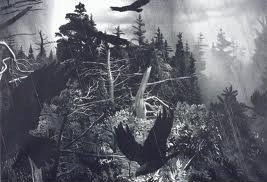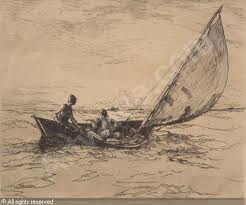
Crows are startled from some secret, wooded coven in the 1946 lithograph, “Untamed,” by Stow Wengroth (1906-1972).
Maine summers are characterized by majestic, almost invisible graces — the sudden rasp of wind the top branches of spruce trees, the crazy spinning of seagulls after a fishing boat, the smell of rain rising up, chalky, from a granite ledge. There is a sense of forces at work upon the landscape that has tantalized artists for centuries.
For the printmaker concerned with the black-and-white image, it is a stiff challenge to capture the forces behind the form, without benefit of color and hue. And yet, the five master printmakers whose works are on display at Rock’and’s Farnsworth Museum manage to use the interplay of black and white to fully convey the ephemeral behind the tangible.
“Imprints of Maine: Master American Prints from the Boston Public Library and Farnsworth Collections,” on display through April 28, presents etchings, lithographs and wood engravings of five American artists who summered in Maine. They range in style from the Hoomeresque etchings of Frank Benson (1862-1951) to Kevin B. O’Callahan’s highly architectural wood engravings of boat hulls. Taken together they are a hymn to the Maine landscape in all its moods of delicacy and drama.
Several of the artists (O’Callahan, Charles Woodbury, Stow Wengroth) have been influenced by architectural and engineering studies, which translate powerfully to the physicality of Maine’s sea and landscapes.
Woodbury, who was a central figure in the art colony at Ogunquit early in the century, uses thin, delicate lines in his etchings to suggest the invisible currents of the sea. The images are sparsely scratched, yet all evoke the oppositional forces at work. In “A Swell,” a single wave rises from a finger of rock, outlined in ghostly cross-hatches. One feels the collision of fog and sea swell and rain, that moment of absolute, wet aloneness.

The vast motions of water and cloud are suggested in the lightest of lines in Frank Benson’s (1862-1951) etching, “Bound Home,” 1918.
Benson’s Impressionistic portraits complement Woodbury’s style. Here, too, the vast motions of water and cloud are suggested in the lightest of lines. “Bound Home,” a 1918 etching, depicts two men in a a dory heading homeward. The mens’ heads are turned away from the blank horizon, facing the distant suggestion of land at the edge of the sail. Small, jagged shapes of wave, rock and cloud are boldly penned in the boat’s sail and hull, a welcomed definition against the vast expanse of sea.
Thomas Nason’s (1889-1971) wood engravings of Deer Isle bespeak the dense, defined contrasts of wood and sea and air. The images are perfectly contained, reminscent of the bold strokes of Rockwell Kent. In “Maine Fishing Village, 1941,” the dark details of forest stand in contrast to the bouldery land where houses sit plainly in the sun. Some of the artist’s actual printing blocks are on display, stained with ink.
Probably the most technically rich prints are by Stow Wengroth (1906-1972), whose photorealistic lithographs do for the Maine coast what Wyeth’s temperas did for the rural Maine interior: They bathed the landscape in a nostalgic, idealized perfection.
They are works that revel in sudden detail — a lighted window, the blueberry scrub ornamenting a bend in the road, the gleam of polished wood in the pews of a simple meeting house. Crows are startled from some secret, wooded coven in the 1946 lithograph, “Untamed.” These are Maine’s private landscapes, moments when the infinitesimal makes itself felt.
The most abstract of the prints — and yet the most closely related to man’s influence on the landscape — are Kevin B. O’Callahan’s shipbuilding series. O’Callahan takes full advantage of the stark contrast of black and white in wood engravure in his studies of boat skeletons. Form is created through the interplay of planes: Patterns of light bring the planks into sharp relief, while creating a scaffolding of shadow.
Of this series, the artist said: “I also feel that good craftsmanship is a much neglected phase of all art today. Too many artist do not take the time to learn their trade.” The invisible boatbuilder is seen as master engineer, working in harmony with the natural powers of light and shadow and form. It is pure, perfect civilization.